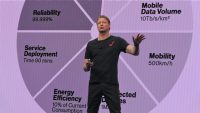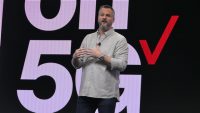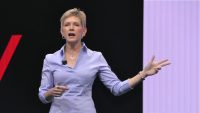Verizon CES Keynote Demonstrates ‘Eight Currencies’ of 5G
January 9, 2019
“5G will change everything,” said Verizon CEO Hans Vestberg in the opening statement of his CES keynote. The exponential enabling power of the 5G network relies on what he called “eight currencies” or capabilities that together produce true 5G. They are peak data rate, mobile data volume, mobility, connected devices, energy efficiency, service deployment, reliability and latency. These “currencies” enable innovation and Vestberg presented initiatives with The New York Times, Walt Disney Studios, Verizon-owned drone operator Skyward, and Medivis, in healthcare, as examples.
Vestberg (below) is not alone in seeing the era of 5G as the start of a fourth industrial revolution, following steam, electricity and digital. “It will transform people, businesses, and society,” he said, while emphasizing that this transformation is “not about what technology can do but what people can do with it.”

He called this “human-ability.” That you can download a movie in 10 seconds instead of minutes is obvious. His bigger question and challenge is how do you apply any one or all of the eight currencies of 5G to do something different.
Mark Thompson, president and CEO of The New York Times Company, showed some early examples of how The New York Times is expanding the palette of tools and techniques to give readers the feeling of being inside the story.
Thompson also explained that NYT is using machine learning to better understand reader interests and preferences and “to harness the personal power of 5G” to delivered a more personalized experience. With 5G, he said, a subscriber’s personal information can be maintained locally. Thompson also suggested that 5G and AI will benefit authentication and verification of user generated and crowd-sourced content.
According to VentureBeat, “the publication will launch a new 5G journalism lab in its offices in New York City. The lab will get early access to Verizon 5G technology and equipment and use the gear in live news. Thompson expects that it will transform the way the publication’s journalists gather news, as well as how it distributes the news — notably including more VR and AR content.”
Walt Disney Studios CTO Jamie Voris (below) introduced the CES audience to StudioLab, an innovation space on the Burbank lot established in 2018, and announced Verizon as a core technology partner. The lab has hosted more than 2,000 production visitors and currently has 25 active projects underway exploring collaboration tools for creatives across the company, drones for location scouting, VR, marketing, and more.

“We see 5G changing everything about how media is produced and consumed,” Voris told Variety, which also reported on a set of large flat screen displays designed to bring movie posters in theater lobbies into the digital age. Voris suggested that these displays could potentially be networked via 5G, making it easier to send digital promotional assets directly to theaters. Whatever the ideal media application for 5G ultimately turns out to be, Voris said that it was important to Disney to jump on the train early.
Disney’s example of drones for location scouting was an ideal setup for Skyward, a Verizon-owned drone solutions company whose mission is “to guide a connected world in the sky.” CEO Mariah Scott (below) announced a commitment by Verizon to be the first carrier to have 1 million drones connected to its 5G network. As she demonstrated a drone flight in Los Angeles launched from the stage in Las Vegas, she said that the combination of drones and real-time data-analysis would transform the way we work and travel.

The most significant impact of low-latency data transmission was demonstrated by Dr. Christopher Morley of Medivis. “The practice of medicine depends on the human connection between practitioner and patient and the connection to data and information to do our jobs,” he said. Morley demonstrated how an AR overlay can transform a delicate surgical procedure. Although such a concept was envisioned more than 60 years ago, it is only now with 5G that this can be possible.
Using low-latency VR goggles, Los Angeles Lakers basketball player Kyle Kuzma set a new top-score in a Pop-A-Shot Basketball challenge.
Vestberg returned to the need for innovation and announced the establishment of Verizon’s “Built on 5G Challenge,” with awards of up to $1 million to fund development of new 5G enabled business and services.
Related:
Verizon Shows Real-World 5G Speeds at CES 2019, Tom’s Guide, 1/8/19
Verizon Adds 1.2 Million Mobile Users, Extending Growth Streak, Bloomberg, 1/8/19
This Is Verizon’s First 5G Smartphone, CNET, 1/8/19

No Comments Yet
You can be the first to comment!
Sorry, comments for this entry are closed at this time.